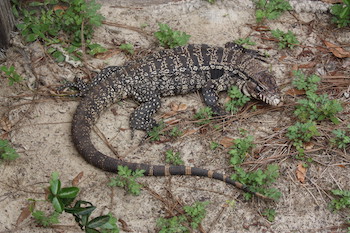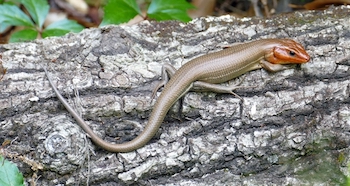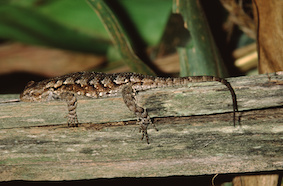
Invasive Lizards Threaten Native Georgia Wildlife
DNR is working to assess and eradicate a wild population of Argentine black and white tegus in Toombs and Tattnall counties in southeast Georgia.
Growing up to 4 feet long and weighing 10 pounds or more, this lizard native to South America is an invasive species that threatens Georgia wildlife.
Tegus will eat the eggs of ground-nesting birds—including quail and turkeys—and other reptiles, such as American alligators and gopher tortoises, both protected species. They will also eat chicken eggs, fruit, vegetables, plants, pet food, carrion and small live animals, from grasshoppers to young gopher tortoises.
There are concerns, as well, that tegus could spread exotic parasites to native wildlife and cause bacterial contamination of crops. Research shows that these reptiles, like most, carry salmonella.
Early detection, rapid response and public involvement are key to stopping tegus in the wild in Georgia.
DNR’s Wildlife Resources Division is working with the public and partners to trap tegus, track sightings and assess the population in the area of Tattnall and Toombs counties.
What You Can Do
Tell DNR when you see a tegu in the wild, alive or dead. These reports help biologists document occurrences and respond effectively. Note the location, take a photo if possible and report the sighting:
- Online: gainvasives.org/argentine-black-and-white-tegu
- Phone: (478) 994-1438
- Email: gainvasives@dnr.ga.gov
Note that as a non-native species, tegus in the wild in Georgia are not protected by state wildlife laws or regulations. They can be legally trapped or killed year-round on private property with landowner permission. Animal cruelty and local ordinances apply, as do appropriate safety precautions. Further details are available in the FAQ below.
On state wildlife management areas, tegus can be taken with firearms legal for the current hunting season or hunt dates on that WMA (i.e., small-game firearms during small game hunt dates; big-game firearms during big-game dates). Using traps to capture tegus on a WMA is not allowed. Hunters and others who see a tegu on a WMA should contact the regional Game Management office.
Be a responsible pet owner. Do your research before buying an exotic pet, and don't let it loose. Georgia lists Argentine black and white tegus as wild animals. They cannot be kept as pets unless they were registered with DNR and tagged before Dec. 4, 2023. Importing and breeding a wild animal species is also illegal.
In Toombs and Tattnall counties, keep pet food inside, fill holes that might serve as shelter and clear yards of debris such as brush piles that can provide cover for tegus.
Tegus at a Glance

- The Argentine black and white tegu (Salvator merianae), largest of all tegu species, is native to Brazil, Paraguay, Uruguay and Argentina.
- Black to dark gray with white speckled bands across the back and tail, these reptiles can weigh 10 pounds or more and live 20 years. Hatchlings have bright green on their heads, a coloration that fades at about 1 month old.
- Sizes vary by age. Hatchlings can be about 6-8 inches long. Adults documented in the wild in Georgia have averaged slightly less than 2 feet.
- Tegus are active by day. These fast-moving, terrestrial lizards are rarely found more than a few feet off the ground. But they are strong swimmers and can stay submerged for extended periods.
- Tegus occupy mixed grassland/woodlands and disturbed habitats such as forest clearings, fence rows and roadsides. They winter in burrows or under cover in a hibernation-like state called brumation. In Argentina, tegus are found from sea level up to altitudes of 4,100 feet.
- Adult tegus have few predators and can multiply quickly. Females reach reproductive age at about 12 inches long or after their second season of brumation. They can lay about 35 eggs a year. Hatching in Georgia would be expected in June/July.
- Argentine black and white tegus are listed as wild animals in Georgia and cannot be imported or bred in the state. They also cannot be kept as a pet if not registered with DNR and tagged before Dec. 4, 2023. Learn more about Georgia's wild animal rules.
- Although not considered aggressive toward people, tegus will defend themselves if threatened. They can react fast and lash with their tails. They have sharp teeth and claws and strong jaws.
- In Georgia, tegus might be confused with native reptiles such as juvenile alligators (which are protected), broadhead skinks and eastern fence lizards (although even as adults, all native lizards would be no larger than a hatchling tegu).


Sources include: Florida Fish and Wildlife Conservation Commission
Resources
Frequently Asked Questions
- Why are tegus a concern in Georgia?

DNR’s Jim Gillis checks a tegu trap in Toombs Tegus are not native to our state and have been known to eat native species including the eggs of alligators and threatened wildlife, such as hatchling gopher tortoises. Tegus may be more cold tolerant than other reptile species and more likely to spread throughout the state.
There are concerns, as well, that tegus could spread exotic parasites to native wildlife and cause bacterial contamination of crops. Research shows that these reptiles, like most, carry salmonella.
Georgia’s State Wildlife Action Plan emphasizes that invasive species are a significant problem for native animals and plants. Invasives compete with native wildlife for food and other resources. They can cause habitat damage and transmit diseases and parasites. In many cases, they also prey on native wildlife. The Wildlife Action Plan is a comprehensive strategy for conserving wildlife and their habitats statewide.
- How widespread are tegus in Georgia?
Georgia’s only known wild population is in Toombs and Tattnall counties. In 2018, DNR’s Wildlife Resources Division, working with DNR Law Enforcement, began investigating reports of Argentine black and white tegus in eastern Toombs and western Tattnall.
Escaped or released tegus are occasionally reported elsewhere in Georgia. This map by UGA’s Center for Invasive Species and Ecosystem Health documents Argentine black and white tegu reports in the U.S.
- How did they get here?
DNR cannot say definitively but it is most likely the tegus in Toombs and Tattnall originated with captive animals that escaped or were intentionally released.
- Are tegus a threat to pets?
While tegus are omnivores and eat a variety of plant and animal matter, they are not considered a threat to pet dogs and cats. However, DNR advises against leaving pet food outdoors: It can attract tegus and other wildlife to your yard.
- Could tegus spread to other parts of Georgia?
Tegus can brumate (reptile hibernation) during colder months, increasing their likelihood for survival across the state. There is scientific evidence suggesting tegus could spread even to other parts of the southeastern U.S. In Florida, tegus have established wild populations and are considered a high-priority exotic, invasive animal targeted for removal from the wild.
- What is being done to deal with tegus in Toombs and Tattnall, or elsewhere in the state?
DNR has worked with partners including the U.S. Geological Society and Georgia Southern University to trap tegus in Toombs and Tattnall counties, removing animals and researching the population. Since 2022, DNR has led the trapping effort. Trapped tegus are humanely euthanized and their diet and reproductive status documented at Georgia Southern. Also, public outreach continues to raise awareness of the threat tegus pose and emphasize the need to report them.
Elsewhere in the state, DNR is responding to reported sightings. Rapid response is key to combating the establishment and spread of tegus and other exotic invasive species.
- Can tegus be owned as pets?
Although popular in the pet trade, Argentine black and white tegus in the wild can cause negative impacts on native wildlife. Georgia added this and five other reptile species to its wild animal list in 2022. “Wild animals” are non-native species that pose a threat to native wildlife, other natural resources or people.
This change immediately banned importing and breeding Argentine black and white tegus in Georgia, and gave pet owners until Dec. 4, 2023, to register, tag and keep their tegus or transfer them to someone who had a wild animal license or permit.
Also please note that it is illegal to release any non-native animal into the wild without a permit.
See the wild animal rules page for information regarding reptile breeders and pet stores.
- Can I kill a tegu if I see it in the wild?
Yes. Tegus are not native to Georgia and as a non-native species they can be killed on private property with the landowner’s permission and using legal methods in accordance with local ordinances, animal cruelty laws and safety precautions.
Also, on DNR WMAs tegus can be dispatched with firearms legal for the current hunting season or dates on that WMA (i.e., small-game firearms during small game hunt dates; big-game firearms during big-game dates). Using traps to catch tegus is not allowed on WMAs. Anyone who sees a tegu on a WMA should also alert that region’s Game Management office.
The American Veterinary Medical Association recommends a two-step process to humanely kill reptiles. The Florida Fish and Wildlife Conservation Commission also provides details regarding nonnative reptiles.
- In the Toombs-Tattnall area, will DNR remove a tegu from my property?
DNR is working to remove tegus from the wild in the area and will respond to confirmed sightings in the area if possible. At sites where a tegu is confirmed, the agency can work with the landowner to provide a live trap, trapping instructions and even help with monitoring the site. Landowners who spot a tegu or tegus on their property should try to get a photograph to verify the presence and contact DNR with the information at (478) 994-1438 or gainvasives@dnr.ga.gov.




















